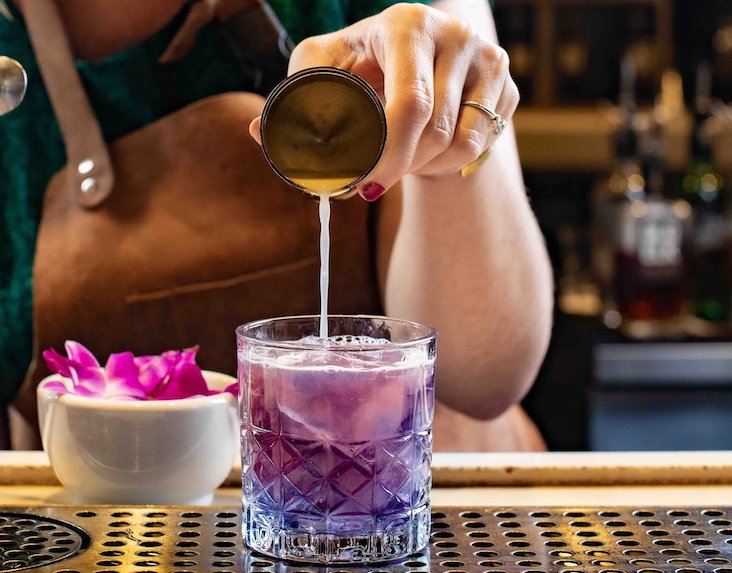BOOTHEEL BARGAINS
As prices for Barolo and Chianti Classico skyrocket, wine buyers keep searching for bargains. Does Apulia hold the answer?
emember when Chianti was still considered a jug wine in the US, and was usually served with the bottle wrapped in a stereotypical straw fiasco? If nothing else, the startling change in the reputation of Chiantis and other such wines prove that Americans will embrace quality wines democratically, whatever their background.
Scorned in many quarters, wines from Apulia (Puglia in Italian), the peninsular heel of Italy’s boot, offer a similar sort of promise on a smaller scale, at least for aggressive beverage pros driven to expand their ever-widening search for quality and value.
The climate in this overlooked peninsula is arid and hot, with cactus dotting the edges of vineyards. It’s also extremely fruitful, custom-made to generate the massive outpouring of olive oil and wine that has come to be associated with it. It’s not surprising that in a formerly poor area like this, to which many Italian-Americans can trace their roots, producing mass quantities became the paramount goal for growers. But many producers of both olive oil and wine have worked hard at developing a reputation for better quality products and concentrating on taming the effects of the heat and lengthy growing season.
Their work comes not a moment too soon, as Apulia, already surpassing Sicily as the country’s leading volume producer, sends by one estimate about 90% of its pressings north (reds especially) as blending wines to infuse backbone and intensity of color and flavor to better-known bottlings, or even as grape concentrate the Italians use instead of sugar to fortify some wines. (Not only does Apulia produce more wine than any other Italian region, but it beats out all but six countries in production.) Hardly any of the wine gets into classified DOC bottlings, even though the region possesses as many of those prized designations as Tuscany.
Some changes have been occurring, but Apulians themselves are modest about their region’s wine prospects. During a recent trip to the region organized by Oldways, a US non-profit which promotes traditional, healthy eating and environmentally sound foods, farming and production methods, US food and wine writers marveled at the many artisanal pastas, breads, varieties of olives and olive oils, as well as producers proudly willing to boast about their products. However, even such luminaries as Severino Garafano, wine-making advisor to such better-known wineries as Taurino and Botromagno, was unnecessarily modest about the possibilities of Apulian wines.
Flying Winemakers
In the UK, importers, agressively seeking partners to develop wine styles suitable for their market, are experimenting with agreeable Pugliese producers to develop more contemporary wine-making methods to fill a niche in Great Britain. The Cantele vineyard, for instance, joined with British importer IWS to develop new styles using careful juice handling and cool fermentation to manage the region’s sometimes robust, high alcohol and cooked-tasting wines, which can be too sweet for most northern palates.
With the help of these so-called “flying winemakers,” producers like Cantele may be walking a fine line between international viability and a loss of regional integrity.
But even the regional winemaking godfather Severino says that only about 10 percent of the region’s wines are currently fit for bottling and exportation. Last spring, however, he said he expects that level to jump to 40 percent within the next ten years. (10 percent, even, may not sound like much, but that’s 10 percent of 1.2 billion liters each year. Apulia produces a lot of wine.)
Some of the wines—specifically Salice Salentino (which derives part of its name from the Salento near the tip of the peninsula) bearing the label of Leone de Castris and Cosimo Taurino—have developed a well-established US reputation. Others, Cantine Borgo Reale, Michele Calo, Conti Zecca and cooperatives such as Cantina Sociale—produce consistent value wines in red, white and rose. Made primarily from negro amaro (black bitter in Italian) grapes and some malvasia nera, better Salices can be a pungent, even agressive wine, with a slightly baked fruit aroma, along with some leather and even game and cured meat aromas.
Some restaurants focusing on Italian foods are not surprisingly leading the way in presenting more Pugliese gems. At New York’s restaurant and enoteca I Trulli (named for the conical stone buildings indigineous to Apulia) carries about 20 reds and seven whites from the area.
Zin Connection
Apulia has been getting more attention lately, perhaps due to the continuing debate over the origins of zinfandel. Primitivo, sometimes cited as a forerunner to zinfandel, can produce an awkward and intense wine under most common Apulian methods—high production in intense summer heat has yielded thick, stewed wines more reminiscent of basement-produced home-made jug wines than the racy zinfandels US drinkers are accustomed to. But groups such as the Accademia Dei Racemi, are promoting methods that may produce grapes lower in sugar, higher in acid and more evenly aromatic.
Even better for these primitivo pioneers, European Union rules have now recognized the primitivo grape as zinfandel, freeing producers to label their wines with a name already very familiar to US buyers. While it may not settle the issue over the grape’s provenance, it will give wine professionals a hook to sell more here.
Cosimo Taurino, one of the pioneers of balanced, engaging wines, warned last spring against the fascination with primitvo. “To make a good wine; it must be used with other grapes.” After 10 years of experimenting, he never bottled a 100% primitivo wine, and won’t get a chance to make his case as more Pugliese producers go modern, as he died suddenly in September, just as his region’s wines seemed poised for greater acceptance.
Taurino, one of the Pugliese pioneers, worked diligently at turning the rough and difficult local grapes into great wines, was beginning think the tide had turned away from the region’s addiction to quantity over quality.
Quality and Value
When he first sent his Notaparano to the US in 1974, the total shipment was 200 cases; last year, importer Leonardo Locascio brought in 65,000 cases of his wines. Of his wines, 92% are bound for export, and almost half of that to the US. The former pharmacist had built a strong market here, and had encouraged a new winemaker to concentrate on the region’s whites.
Since taking over Botromagno winery from the bankrupt cooperative in 1991, Beniamino D’Agostino has left a law practice in Bari to realize his passion for wine. Garafano, now advising Botromagno, when asked by D’Agostino about the prospects for the vineyard, “This is not a good winery right now, but I know the grapes and I think you can make the best white wine in the region from them.” That settled it.
D’Agostino began to focus on combining modern methods and local traditions. Local grapes come from small coops and farmers, who have changed their cropping methods at his request to get a lower but higher quality yield. His Silvium rose, soon available in the US, shows promise, and the Gravina white is a perfect warm weather quaff.
But the best known rose maker in Apulia is without doubt Leone De Castris, whose family bottled the first rose in Italy, Five Roses, at the request of a departing US general after WWII. One of the De Castris family’s Salice Salentinos, recently received a coveted Tre Biccheri from Italy’s leading wine guide Gambero Rosso. The 1993 De Castris Donna Lisa Riserva Salice Salentino was the only Pugliese wine to win the distinction this year.
Some of the other wines that showed well in Apulia last spring include the 1998 Silvium Rosato (Botromagno), 1996 La Terre di Federico Verdeca delle Murge, 1998 Rivera Castel del Monte Dama di Svevia (100% bambino bianco), 1998 Gravina Botromagno, 1997 San Severo Rosato Torella, 1998 Torre di Dora, 1997 Taurino Notapanaro and Salice Salentino, 1994 and 1998 De Castris Five Roses, 1993 Donna Lisa Riserva Rosso Salice Salentino, the 1993 Taurino Patriglione Riserva Salice Salentino.




